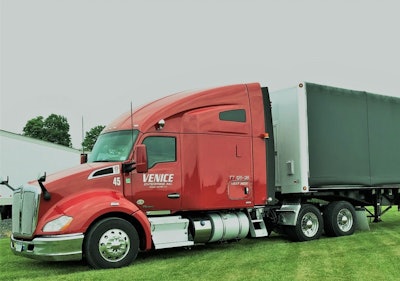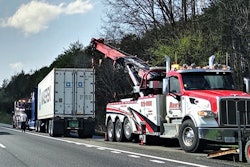 Venice Enterprise, pulling various trailer types (including this curtainside flatbed) out of New York State, is among an unknown number of small fleets to receive a Satisfactory safety rating as a result of an entirely offsite audit in 2020. It's among the few bright spots in FMCSA's turn to offsite review work during the pandemic.
Venice Enterprise, pulling various trailer types (including this curtainside flatbed) out of New York State, is among an unknown number of small fleets to receive a Satisfactory safety rating as a result of an entirely offsite audit in 2020. It's among the few bright spots in FMCSA's turn to offsite review work during the pandemic.Federal Motor Carrier Safety Administration enforcement chief Joe DeLorenzo said the agency so far has “felt good about how [off-site audits] have worked and how the agency was able to transition” quickly to those remote audits, somewhat out of necessity, when the pandemic hit. He spoke Wednesday at the agency’s 20th annual Analysis, Research, and Technology Forum, held virtually this year and broadcast live via Microsoft Teams.
DeLorenzo said it was a stroke of luck, too, that the agency was already planning to leverage off-site audits on a greater scale in carrier interventions in 2020. The year’s “blended approach,” he said, resulted in a roughly 50-50 split in off-site vs. on-site, in-person audits. The pandemic simply sped up the implementation of “where we were headed anyways." So far, “remote investigations do not hamper our ability to discover violations,” he said, and the agency has deemed the jump in off-site audits a success.
That shift, however, contrary to what some observers expected, might be more of a failure when measured by safety ratings issued.
 Compared to 2019 levels, ratings of Satisfactory, Conditional or Unsatisfactory, considered together, were down on the whole by almost 40%, greatly accelerating the downward rating trend of the last several years.Data from FMCSA's Motor Carrier Management and Information System
Compared to 2019 levels, ratings of Satisfactory, Conditional or Unsatisfactory, considered together, were down on the whole by almost 40%, greatly accelerating the downward rating trend of the last several years.Data from FMCSA's Motor Carrier Management and Information System

Compared to the relatively modest fall in various focused and more comprehensive audits conducted, the huge fall in safety ratings suggests hesitancy on the part of federal and state auditors to depart too much from pre-pandemic procedure by issuing ratings as a result of a solely off-site investigation.
[Related: Owner-operators and small fleets remain in crosshairs of DOT’s offsite audits]
That doesn't mean it hasn't been done at all, however, said Jeff Davis of Ohio-based Fleet Safety Services, who assists motor carriers facing investigations in various ways. He's seen firsthand that blended remote/onsite approach develop. The agency's "remote on-site" term refers to what Davis sees as a hybrid approach to audits started at the federal level offsite but finished out by state investigators.
"I've got four off-sites that ended up being issued Unsatisfactory ratings" after state investigators got involved, he added. "They're figuring out a way to do it."
Colleen Rejman, of the 14-truck/six-driver Venice Enterprise fleet in New York state, can count her fleet as one of those carriers to receive a Satisfactory rating as a result of a purely offsite audit, she said. It followed from a growing desire on the part of the fleet to upgrade a Conditional rating received in 1988 with a promise by auditors to come back after problems were corrected.
"Well, they just never came back," Rejman said. In the meantime, the Conditional wasn't much of a hindrance to their growing business, built on serving direct customers rather than unfamiliar brokers.
Such an adverse rating, however, has assumed greater importance as information and technology to access it have abounded in recent years. When the pandemic hit, Venice followed through on its plans and requested an audit from a New York-headquartered FMCSA agent, who conducted it over two to three months entirely off-site. In July, they were issued a Satisfactory rating.
In terms of freight, "getting an upgrade to Satisfactory has been a game-changer," Rejman said, though finding drivers to move it all continues to be a challenge.
The Venice Enterprise experience of an off-site may not exactly be the norm, however, Davis contended. Because an offsite audit most often targeted to a problem area in an operation, there's a good chance it will uncover problems. That can result in a ratings downgrade rather than an upgrade. "With any focused audit that happens, you cannot get an upgrade," Davis said, speaking of rules in normal times.
Davis added that the agency and state partners have "virtually stopped doing full, complete audits," or compliance reviews, "upon request," a phenomenon that certainly predates the pandemic. That can make it difficult for those saddled with a Conditional rating to get an upgrade, the Venice experience notwithstanding.
Despite that, Satisfactory ratings issued were mostly in line with prior years on a percentage basis in 2020.
 Compared to 2019, the percentage of Satisfactory ratings issued in the heavily offsite year of 2020 was down, but only by approximately 3 percentage points. All of that and more was made up by the Conditional rating's share, up about five points.Data from FMCSA's MCMIS database
Compared to 2019, the percentage of Satisfactory ratings issued in the heavily offsite year of 2020 was down, but only by approximately 3 percentage points. All of that and more was made up by the Conditional rating's share, up about five points.Data from FMCSA's MCMIS database
[Related: Trapped in a CSA nightmare]
Joe Rajkovacz, former owner-operator and now head of government affairs at the Western States Trucking Association, feels a turn to offsite auditing makes some sense. If it does represent the future of the carrier compliance review, it ought not to be difficult to master for small trucking companies, including one-truck independents.
"We really push our people to take care of the back-office stuff," he said of the mostly small carriers his association helps through New Entrant audits and more. Achieving a Satisfactory rating, he feels, is principally a consequence of being "really good at doing paperwork," storing for ready access logs data, driver qualification files, Drug and Alcohol Clearinghouse compliance paperwork and so much more.
"We're well aware Unsats are being issued for failure to comply with Drug and Alcohol Clearinghouse registration" and running its required annual queries, Rajkovacz pointed out. It's something easily achieved for a small fleet and which, according to recent Overdrive polling, as much as a third of respondents didn't do over the first year of the clearinghouse.
As for drug and alcohol testing compliance, Rajkovacz added, "It’s amazing how many people toss out their chain of custody control forms. These documents will be requested to be uploaded and sent" during an offsite review in most cases.
Davis believes there's a bit of trap, too, for carriers. That's because of the way offsite reviews can approach hours of service, given that category (along with crash) assumes much more weight in the safety rating methodology than most others. With an offsite review, auditors are required to sample fewer drivers' logs than with a traditional audit. All the way up to a 50-truck fleet requires a sample of only three drivers' logs, for instance, rather than the usual seven. Out of that sample, Davis noted, a bad apple has a much better chance of ruining the bunch, resulting in a safety rating downgrade.
"This rating methodology hasn’t been changed" much for decades, Davis said. FMCSA's pursuit of a Safety Fitness Determination rating methodology reliant in part on CSA's BASIC categories of measurement was famously scrapped during the Trump administration after complaints about those categories' problematic nature. Likewise, efforts to reform CSA, furthermore, seem mostly stalled or non-existent, despite efforts made by Congress to force FMCSA's hand in overhauling the system.
Davis believes regulators ought to at least make the hours of service "not as severe" in the rating methodology's computation, given the existence of electronic logging devices and the eRODS system for analyzing log data. "It's now man against machine in that audit," he added, a battle carriers without rigorous logs management are bound to lose.
FMCSA's DeLorenzo, during his Wednesday presentation, shared stats that show a slightly softer edge for off-site audits. Violation-discovery rates were at least somewhat lower off-site than on-site -- 92% compared to 97% for on-site focused reviews -- and about the same as the rate in comprehensive on-site reviews. The important “acute/critical” violation rate was significantly lower (30%) for off-site audits, compared to 48% for on-site focused and 56% for on-site comprehensive audits.
 About a third of a sampling of independent owner-op/small-fleet Overdrive readers reported receiving an entirely offsite audit in 2020. Among that group, about the same amount received as a Satisfactory safety rating as received not rating outcoming at all. The pie chart above shows the majority Satisfactory results of those readers' solely off-site audits in 2020. You can count Venice Enterprise and Colleen Rejman among that group, having received its upgrade from Conditional in July.Overdrive poll
About a third of a sampling of independent owner-op/small-fleet Overdrive readers reported receiving an entirely offsite audit in 2020. Among that group, about the same amount received as a Satisfactory safety rating as received not rating outcoming at all. The pie chart above shows the majority Satisfactory results of those readers' solely off-site audits in 2020. You can count Venice Enterprise and Colleen Rejman among that group, having received its upgrade from Conditional in July.Overdrive poll
When the pandemic eases, offsite audits are here to stay as an enforcement tool for the agency, DeLorenzo added during his presentation.
-- James Jaillet contributed to this report










